Tanegashima (gun)
Tanegashima (種子島), most often called in Japanese and sometimes in English hinawajū (火縄銃, "matchlock gun"), was a type of matchlock[1]-configured arquebus[2] firearm introduced to Japan through the Portuguese Empire in 1543.[3] Tanegashima were used by the samurai class and their ashigaru "foot soldiers", and within a few years the introduction of the tanegashima in battle changed the way war was fought in Japan forever.[4]
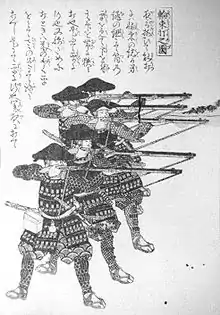
History
Origins
The tanegashima seems to have been based on snap matchlocks that were produced in Portuguese Malacca, at the armory of Malacca, a colony of Portugal since 1511, called an istinggar in Malay.[5] The name tanegashima came from the Japanese island (Tanegashima) where a Chinese junk with Portuguese adventurers on board was driven to anchor by a storm in 1543. The lord of the Japanese island, Tanegashima Tokitaka (1528–1579), purchased two matchlock muskets from the Portuguese and put a swordsmith to work copying the matchlock barrel and firing mechanism. The smith, Yaita, did not have much of a problem with most of the gun but "drilling the barrel helically so that the screw (bisen bolt) could be tightly inserted" was a major problem as this "technique did not apparently exist in Japan until this time." The Portuguese fixed their ship and left the island and only in the next year when a Portuguese blacksmith was brought back to Japan was the problem solved.[6] Within ten years of its introduction, over 300,000 tanegashima firearms were reported to have been manufactured.[7]
Sengoku period
Much of Japan was involved with internecine wars during the Sengoku period (1467-1603), as feudal lords vied for supremacy.[8] Matchlock guns were introduced midway through the period and saw extensive use in the later years of the conflict, playing a decisive role on the battlefield. In 1549, Oda Nobunaga ordered 500 guns to be produced for his armies at a time when the benefits of firearms over traditional weapons were still relatively questionable to other daimyōs. However the new firearm had undoubted advantages in range in comparison with traditional bows. In addition, bullets could penetrate almost any armor and shield.[9] Joseon official Ryu Seong-ryong quoted:
In the 1592 invasion, everything was swept away. Within a fortnight or a month the cities and fortresses were lost, and everything in the eight directions had crumbled. Although it was [partly] due to there having been a century of peace and the people not being familiar with warfare that this happened, it was really because the Japanese had the use of muskets that could reach beyond several hundred paces, that always pierced what they struck, that came like the wind and the hail, and with which bows and arrows could not compare.[10]
But a significant drawback was the high price of each musket and the long production time. Ryu Seong-ryong:
However, the musket is a very intricate instrument, and very difficult to produce. The Jixiao Xinshu [written by Qi Jiguang in 1560] says one month for boring the barrel is optimal–that is, one musket takes the labor of one person for one month before it is ready for use. The difficulty and expense are like that. In recent days, the muskets used by the supervisorate have all been captured Japanese weapons. There are not many and they frequently burst, becoming fewer by the day.[11]
The Japanese soon worked on various techniques to improve the effectiveness of their guns. They developed a staggered firing technique to create a continuous rain of bullets on the enemy.[12] They also developed larger caliber barrels and ammunition to increase lethality.[12] Protective boxes in lacquerware were invented to fit over the firing mechanism so it could still fire while it was raining,[13] as were systems to accurately fire weapons at night by keeping fixed angles thanks to measured strings.[14] Another development would be the hayago, a bamboo cartridge used to facilitate faster reloading.[15] A hollow tube open on the both ends, the hayago contained gun powder, wadding, and a bullet. Upon tearing open the tube's paper seal at the bottom, a soldier could quickly use it to pour the necessary powder into his weapon before placing over the barrel and using his rammer to load both wadding and bullet into the barrel at the same time. After use, the hayago could be kept for repacking or discarded.[15]

In 1563 the Amago clan of Izumo Province won a victory over the Kikkawa clan with 33 of their adversaries wounded by tanegashima.[16] In 1567, Takeda Shingen announced that, "Hereafter, the guns will be the most important arms, therefore decrease the number of spears per unit, and have your most capable men carry guns".[17] Oda Nobunaga used tanegashima in the Battle of Anegawa (1570), and again against the powerful Takeda clan in the Battle of Nagashino (1575), 3,000 gunners helped win the battle, firing by volleys of a thousand at a time. They were concealed across a river and used breastworks to effectively stop enemy infantry and cavalry charges while being protected.[18] The defeat of the powerful Takeda clan brought about permanent changes in battle tactics.
Japan became so enthusiastic about the new weapons that it possibly overtook every European country in absolute numbers produced.[19] Japan also used the guns in the Japanese invasion of Korea in 1592, in which about a quarter of the invasion force of 160,000 were gunners.[20] They were extremely successful at first and managed to capture Seoul just 18 days after their landing at Busan.[21]
Edo period
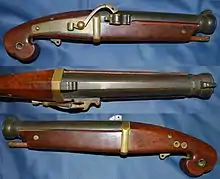
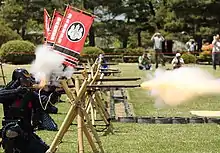
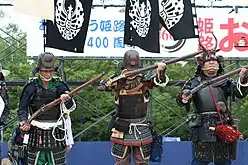
The internal war for control of Japan was won by Tokugawa Ieyasu, who defeated his rivals at the Battle of Sekigahara in October 1600. Three years later, he established the Tokugawa shogunate, a powerful entity that would maintain peace, stability, and prosperity in Japan for the following 250 years. This is known as the Edo period (1603–1868). From the mid 17th century, Japan decided to close itself to interaction with the West except for the Dutch Republic through its policy of Sakoku. Contrary to popular belief, this did not lead to Japan "giving up the gun." If anything, the gun was used less frequently because the Edo Period did not have many large-scale conflicts in which a gun would be of use. Often the sword was simply the more practical weapon in the average small-scale conflicts. Isolation did not eliminate the production of guns in Japan—on the contrary, there is evidence of around 200 gunsmiths in Japan by the end of the Edo Period.[22] But the social life of firearms had changed: as the historian David L. Howell has argued, for many in Japanese society, the gun had become less a weapon than a farm implement for scaring off animals.[23] With no external enemies for over 200 years, tanegashima were mainly used by samurai for hunting and target practice, the majority were relegated to the arms store houses of the daimyōs.
The arrival in Japan of the United States Navy led by Matthew C. Perry in 1854 started a period of rearmament. The tanegashima was an antiquated weapon by the 1800s and various samurai factions acquired advanced firearms including the minié rifle, breech-loading and repeating rifles. The samurai era ended in 1868 with the Meiji; Japan turned to a national conscription army with modern weapons and uniforms. Some gunsmiths did replace their matchlock-type tanegashimas into percussion cap mechanisms while retaining its design as a musket. The last use of samurai armour and traditional weapons in Japan, including tanegashima, was during the Satsuma Rebellion (1877), when the Meiji government's newly established Imperial Japanese Army put an end to the last samurai and their resistance to modernization.
Modern use
Today tanegashima are readily available from sellers of antique firearms and dealers of samurai antiques both in Japan and the West. Modern tanegashima gun troops in Japan re-enact the use of tanegashima in battle and black powder enthusiasts use tanegashima for target practice.[24]
Parts
- Shiba-hikigane – Butt Protector
- Hikigane – Trigger
- Karakuri – Lock
- Jiita – Plate
- Yuojintetsu – Trigger Guard
- Biyu – Rivet
- Hinawa Toushi Ana – Hole for the Matchcord
- Hajiki Gane – Spring
- Dugane – Stock Ring
- Hibasami – Hammer Arm
- Amaoi – Barrel Protector
- Hibuta – Pancover
- Hizara – Pantray
- Dai – Stock
- Tsutsu – Barrel
- Moto Maete – Rear Sight
- Udenuki – Sling Hole
- Naka Maete – Middle Sight
- Mekugi Ana – Pin Hole
- Saki Maete – Front Sight
- Karuka – Ramrod
- Suguchi – Muzzle
Gallery
 Edo-period Tanegashima firing mechanism
Edo-period Tanegashima firing mechanism_tamegashima_(matchlock)_firing_mechanism.JPG.webp) The inside of the arquebus's firing mechanism
The inside of the arquebus's firing mechanism Edo-period tanegashima showing the barrel bolt
Edo-period tanegashima showing the barrel bolt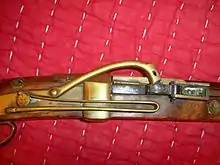 Edo-period tanegashima firing mechanism
Edo-period tanegashima firing mechanism
See also
References
- East Asia: A Cultural, Social, and Political History, Authors Patricia Ebrey, Anne Walthall, James Palais, Publisher Cengage Learning, 2008, ISBN 978-0-547-00534-8 P257
- Lidin, Olof G. (2002). Tanegashima: the arrival of Europe in Japan. NIAS Press. p. 4. ISBN 978-87-91114-12-0.
- Tanegashima: the arrival of Europe in Japan, Olof G. Lidin, Nordic Institute of Asian Studies, NIAS Press, 2002 P.1-14
- Noel Perrin (1979). Giving up the gun: Japan's reversion to the sword, 1543-1879. David R Godine. ISBN 9780879237738. Retrieved 2011-09-22.
- Daehnhardt, Rainer (1994). Bewitched gun. Texto Editora. p. 26. ISBN 978-972-47-0373-2.
- Lidin, Olof G. (2002). Tanegashima: The Arrival of Europe in Japan. Taylor & Francis. p. 142. ISBN 978-0-203-47957-5.
- Nagayama, Kōkan (1997). The Connoisseur's Book of Japanese Swords. Kodansha International. p. 30. ISBN 978-4-7700-2071-0.
- Perrin p.9
- Andrade, Tonio. (2016) The Gunpowder Age p. 184: "When [our] soldiers are lined up against the enemy ranks, our arrows do not reach the enemy while their musket balls rain down upon us."
- Firearms: A Global History to 1700 by Kenneth Chase
- Firearms: A Global History to 1700 by Kenneth Chase
- Perrin p.17
- Perrin, p.18
- Perrin, p.40
- Wayland, Dean. "TEPPŌ Japanese Matchlock Guns". The Fight School.
- Ferejohn, John A.; Rosenbluth, Frances McCall (2010). War and State Building in Medieval Japan. Stanford University Press. p. 147. ISBN 978-0-8047-7431-4.
- Perrin, p.17
- Perrin p.19-20
- Perrin p.25
- Perrin p.27
- Perrin p.28
- Samurai Archives Podcast EP05 "The Myth of Samurai Giving Up the Gun". Retrieved August 13, 2013.
- Howell, David L. (1 May 2009). "The Social Life of Firearms in Tokugawa Japan". Japanese Studies. 29 (1): 65–80. doi:10.1080/10371390902780530.
- http://www.gunsamurai.com
Further reading
- Tanegashima: the arrival of Europe in Japan, Olof G. Lidin, Nordic Institute of Asian Studies, NIAS Press, 2002
- The bewitched gun : the introduction of the firearm in the Far East by the Portuguese, by Rainer Daehnhardt 1994 ISBN 978-972-47-0373-2
- The Japanese matchlock (in English), color printing, 60 pages, Shigeo Sugawa
- Giving up the gun: Japan's reversion to the sword, 1543-1879, Noel Perrin, David R. Godine Publisher, 1979
External links
| Wikimedia Commons has media related to Japanese matchlocks. |
- The varieties of Japanese matchlock (tanegashima).
- Tanegashima information.
- Tanegashima accessories
- Parts of the tanegashima
- Matsumoto Castle Gun Corps
.jpg.webp)